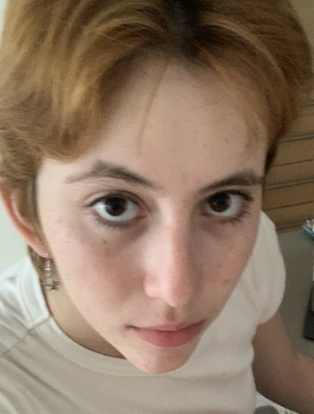The Face We Were Never Meant To See
October 6, 2022
In the age of selfies, one look at Instagram, TikTok, or Snapchat is a barrage of faces and bodies. The internet has become a presentation of the self in which we commodify smiles and poses with awkward hands lingering on beveled knees. Here is a chance to look at yourself. Here, have a little peek. Try to pose like a model and spend an hour deliberating on whether or not your hip looks strange. Has it always stuck out like that? Ugh. Why does anyone even look at you? And so we turn to scream at the top of our lungs about self-love. Influencers and unknown users post about their struggle to look in the mirror and find themselves beautiful. We take to sticking post-its to mirrors or writing on them with dry-erase markers. Or, if you are like me, you try to carve out a cave under the mountain that is the internet where your own face goes unacknowledged. In the damp dark down here, we cannot see each other. We only have our voices.
On a recent stay in my cave, I scrolled past the post pictured. User fanaas says, “i just dont think we were made to look at ourselves.” Malaak responds with two quotes, the first from The Book of Disquiet by Fernando Pessoa and the second from Immortality by Milan Kundera. It was seven in the morning, and school was fast approaching, but the words stuck with me for the rest of the day. Then the rest of the week. Now it has been over a month. I am still thinking: am I supposed to know my own face?
Before mirrors were invented, humankind had only reflections in pools to see themselves. Our reflections were warped – the water’s surface rippled with the breeze and the tides. You could see a murky reflection staring back at you, but nothing significant. Our faces were as defined as the clouds floating across the sky. And yet we deemed those flimsy images a danger. The Ancient Greeks wrote of Narcissus, a man who (already being prone to pride) glimpsed his reflection in a lake and fell madly in love with himself. He sat there staring at his reflection for days. The ground grew around his legs, and still, he stayed, eventually dying of starvation. Narcissus turned to flowers and is now the namesake of a medical condition: narcissism. The flowers are named after him, too.
Similarly, the doppelgänger from German folklore is a mirror image of a living person whose appearance is an omen of bad luck or death. This concept of an “evil twin” has pervaded literature and film from Fyodor Dostoyevsky’s The Double to the popular show The Vampire Diaries. Even Superman has a mirror-self: Bizarro. Representing the total-reverse of Superman, Bizarro often plays the villain, murdering civilians and failing to understand the difference between good and evil. Then there are stories like Stranger Things, where mirror dimensions spill chaos and cruelty into the world.
But why are mirrors so often used to represent corruption and evil? It might be a result of the inaccuracies held within our reflection. In a 2008 article from The New York Times called “Mirrors Don’t Lie. Mislead? Oh, Yes.”, a doctor who studied the nature of mirrors explained the harsh reality. “Outline your face on a mirror, and you will find it to be exactly half the size of your real face” (Angier 2008). My mother and my flimsy experimentation was terrifying proof. While the length of my head, from chin to crown, is about eight inches, my reflection declared it only four and a half to five. Stepping closer to the glass changed nothing. The article states, “Step back as much as you please, and the size of that outlined oval will not change…even as the background scene reflected in the mirror steadily changes” (Angier 2008). And that is without mentioning how we perceive our reflection’s attractiveness.
Proclaiming an inanimate object’s morality is impossible. Morality is something we imbue onto something, relying on the relationship between the object and the self (or society). A knife is not inherently evil. A ribbon is not inherently good.
Mirrors, photography, and social media have made us exceptionally aware of how we look. I often wonder how big my eyes are or how messy my hair is, simply because others are around me. Would the extinction of such technology erase this obsession? I don’t know.
I like to think my life would be better if I could not see my reflection. There would be no dissection of my own face. My friends and family would have to describe the color of my eyes and the shape of my nose. I would only know what I look like from kaleidoscopic reflections and shadows cast by the sun. I would know my body as the feet that carry me where I want to go, the
heart that beats the blood through my veins, the hands that tear grass from the earth.
Kundera prompts us to “imagine living in a world without mirrors.” We can theorize all we want, but we will never know. Maybe we were not meant to see our own faces — maybe our faces are not truly us. Either way, it’s too late. We have stared down our reflections. Now we must decide what to do with that knowledge.












